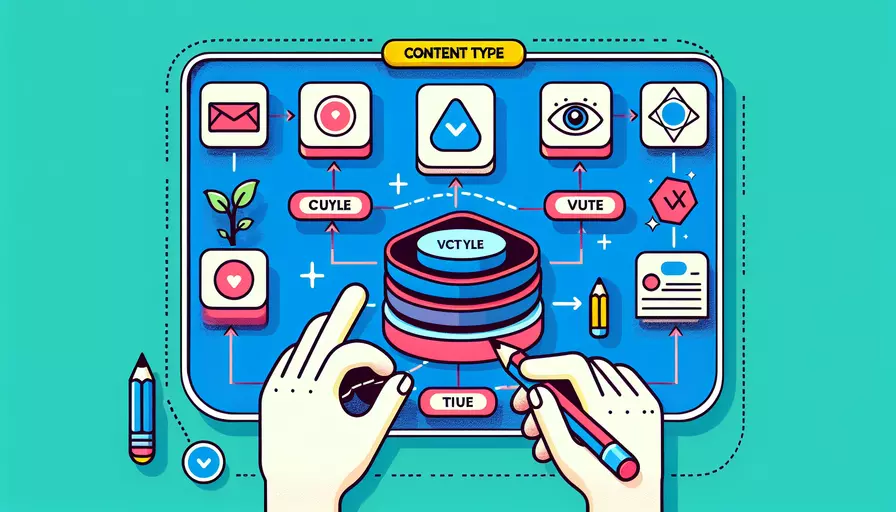
在Vue.js中,确定content type主要涉及1、HTTP请求头的设置和2、模板内容的渲染。对于HTTP请求头的设置,可以通过Axios或Fetch等工具来配置。对于模板内容的渲染,则可以通过Vue模板语法和指令来确保正确的内容类型。接下来,我们将详细解释这两种情况。
一、HTTP请求头的设置
在Vue.js项目中,常用的HTTP请求库是Axios。我们可以通过Axios配置来设置请求的content type。以下是具体步骤:
-
安装Axios:
npm install axios -
配置全局默认content type:
import axios from 'axios';axios.defaults.headers.common['Content-Type'] = 'application/json';
-
在具体请求中设置content type:
axios.post('/api/example', data, {headers: {
'Content-Type': 'application/x-www-form-urlencoded'
}
});
解释和背景信息
-
为什么需要设置content type:
Content type(内容类型)告诉服务器具体请求中的数据格式,从而使服务器能够正确解析请求体。常见的Content-Type包括
application/json、application/x-www-form-urlencoded和multipart/form-data。 -
实例说明:
比如,在提交表单数据时,如果不设置正确的Content-Type,服务器可能无法正确解析数据,导致请求失败。
二、模板内容的渲染
Vue.js通过其模板语法和指令来确保渲染的内容类型正确。以下是具体步骤和示例:
-
文本插值:
<div>{{ message }}</div> -
HTML插值:
<div v-html="rawHtml"></div> -
绑定属性:
<img v-bind:src="imageSrc" alt="example image"> -
条件渲染:
<div v-if="isTrue">Content A</div><div v-else>Content B</div>
解释和背景信息
-
为什么需要关心模板内容类型:
确保模板内容类型正确可以防止XSS攻击,保证页面安全。同时,它可以确保正确的内容格式,从而提升用户体验。
-
实例说明:
比如,在处理用户输入的HTML时,需要使用
v-html指令,这样可以确保HTML内容被正确解析和渲染。
三、表单提交的content type
表单提交时,Content-Type的选择非常重要。以下是几种常见的表单提交类型及其设置方法:
-
application/x-www-form-urlencoded:
axios.post('/api/form', querystring.stringify(data), {headers: {
'Content-Type': 'application/x-www-form-urlencoded'
}
});
-
multipart/form-data:
const formData = new FormData();formData.append('file', file);
axios.post('/api/upload', formData, {
headers: {
'Content-Type': 'multipart/form-data'
}
});
-
application/json:
axios.post('/api/json', JSON.stringify(data), {headers: {
'Content-Type': 'application/json'
}
});
解释和背景信息
-
为什么选择不同的content type:
不同的Content-Type适用于不同的数据格式和传输需求。例如,
application/json适合传输JSON格式的数据,multipart/form-data适合文件上传,application/x-www-form-urlencoded适合表单数据。 -
实例说明:
比如,在进行文件上传时,必须使用
multipart/form-data,否则文件数据无法正确传输,导致上传失败。
四、综合实例
为了更好地理解如何确定和设置content type,我们通过一个综合实例来说明。在这个实例中,我们将创建一个Vue组件,包含一个表单用于提交数据,并通过Axios发送HTTP请求。
- 创建Vue组件:
<template><div>
<form @submit.prevent="handleSubmit">
<input v-model="name" placeholder="Name">
<input type="file" @change="handleFileUpload">
<button type="submit">Submit</button>
</form>
</div>
</template>
<script>
import axios from 'axios';
export default {
data() {
return {
name: '',
file: null
};
},
methods: {
handleFileUpload(event) {
this.file = event.target.files[0];
},
handleSubmit() {
const formData = new FormData();
formData.append('name', this.name);
formData.append('file', this.file);
axios.post('/api/submit', formData, {
headers: {
'Content-Type': 'multipart/form-data'
}
}).then(response => {
console.log('Success:', response.data);
}).catch(error => {
console.error('Error:', error);
});
}
}
};
</script>
解释和背景信息
-
为什么使用FormData:
在这个实例中,使用FormData可以方便地将表单数据和文件一起上传。通过设置Content-Type为
multipart/form-data,可以确保服务器正确解析文件和其他表单数据。 -
实例说明:
提交表单时,通过
handleFileUpload方法处理文件上传,并通过handleSubmit方法将数据提交到服务器。Axios配置中的Content-Type确保数据格式正确,服务器能够正确解析请求体。
五、总结和建议
通过以上内容,我们了解到在Vue.js中确定和设置content type的关键方法。1、在HTTP请求中设置合适的Content-Type,确保服务器能够正确解析请求体;2、通过Vue模板语法和指令,确保渲染内容的类型正确。另外,在表单提交时,根据数据格式选择合适的Content-Type,如application/json、application/x-www-form-urlencoded和multipart/form-data。这些措施可以提高应用的可靠性和安全性。
为了更好地应用这些知识,建议开发者在实际项目中:
- 根据需求选择合适的Content-Type,确保数据能够正确传输和解析。
- 使用Vue模板语法和指令,确保渲染内容的安全性和正确性。
- 定期审查和更新项目的依赖库,以利用最新的功能和安全性改进。
通过这些步骤,可以提升Vue.js应用的性能和安全性,提供更好的用户体验。
相关问答FAQs:
1. Vue中如何确定content type是什么?
在Vue中,确定content type的方式取决于你使用的是哪种请求库。一般来说,你可以使用Axios或者Fetch API来发送HTTP请求。下面将分别介绍这两种方式。
2. 使用Axios库时如何确定content type?
Axios是一个常用的HTTP请求库,它可以帮助你发送异步请求。在Axios中,你可以通过设置请求的headers来确定content type。
首先,你需要引入Axios库:
import axios from 'axios';
然后,你可以使用Axios的post或put方法来发送请求,并在请求的配置中设置headers:
axios.post('/api/endpoint', data, {
headers: {
'Content-Type': 'application/json' // 设置content type为JSON
}
})
.then(response => {
console.log(response);
})
.catch(error => {
console.error(error);
});
在上面的例子中,我们将content type设置为JSON,你可以根据你的需求设置不同的content type,如form-urlencoded、multipart/form-data等。
3. 使用Fetch API时如何确定content type?
Fetch API是浏览器原生提供的一种发送HTTP请求的方式。在Fetch API中,你可以使用Headers对象来设置请求的headers,并在其中确定content type。
首先,你可以使用new Headers()来创建一个空的headers对象:
const headers = new Headers();
然后,你可以使用headers对象的append方法来添加header字段:
headers.append('Content-Type', 'application/json'); // 设置content type为JSON
最后,你可以使用fetch函数发送请求,并在请求的配置中设置headers:
fetch('/api/endpoint', {
method: 'POST',
headers: headers,
body: JSON.stringify(data)
})
.then(response => {
console.log(response);
})
.catch(error => {
console.error(error);
});
在上面的例子中,我们将content type设置为JSON,你可以根据你的需求设置不同的content type,如form-urlencoded、multipart/form-data等。
总结:在Vue中确定content type的方式取决于你使用的是哪种请求库。如果你使用的是Axios,可以通过设置请求的headers来确定content type;如果你使用的是Fetch API,可以使用Headers对象来设置请求的headers。根据你的需求,可以将content type设置为不同的值,如JSON、form-urlencoded、multipart/form-data等。
文章标题:vue如何确定content type,发布者:worktile,转载请注明出处:https://worktile.com/kb/p/3625609

 微信扫一扫
微信扫一扫  支付宝扫一扫
支付宝扫一扫 